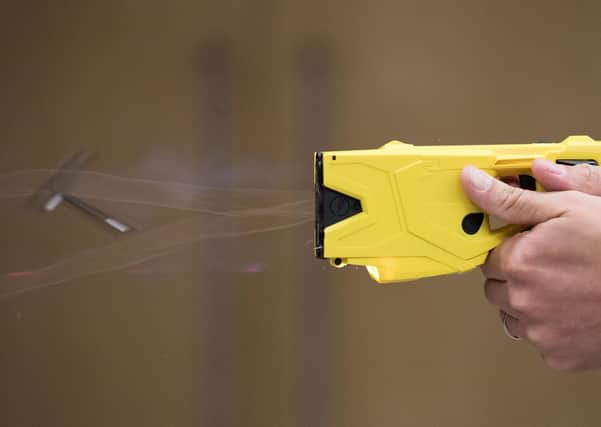Tasers used on children by Cambridgeshire police a dozen times last year


Officers reported firing the electrical weapons in two of those cases.
The Children’s Rights Alliance for England says the recorded increase in use of Tasers against children by police forces across England and Wales is “alarming”.
Advertisement
Hide AdAdvertisement
Hide AdThe children’s human rights charity says “being threatened” with a Taser can be extremely frightening for a child even if the weapon is not fired, and has called for a ban on their use on young people.
Home Office figures show Cambridgeshire Constabulary drew Tasers on children aged under 18 on 12 occasions in 2019-20, although this was down from 18 the previous year.
The figure counts the number of times each officer involved in an incident used the device rather than the number of separate incidents or how many children were involved. The age recorded is that perceived by the officer.
Officers fired a Taser twice, although neither of those cases involved under-11s, according to the records.
Advertisement
Hide AdAdvertisement
Hide AdWhen fired, Tasers are designed to temporarily incapacitate someone by giving them an electric shock. A device can be fired at someone from a distance or held against their body to stun them.
Overall, officers at Cambridgeshire Police recorded using some form of force on children on 799 occasions last year – more than half (51 per cent) of those were for restraint, which can include handcuffing, restraining someone on the ground, or using specialist equipment to reduce the movement of someone’s arms and legs.
Other use of force can include using firearms, equipment such as batons, shields and irritant spray, and dogs.
Across the 43 police forces in England and Wales, Tasers were used on children on 2,818 occasions in 2019-20, up from 1,700 the previous year.
Advertisement
Hide AdAdvertisement
Hide AdThey were fired in 134 cases, none of which involved children under 11. More and more officers are being trained to use Tasers as forces become more used to using them.
Louise King, director of the Children’s Rights Alliance for England, said: “The UN Committee on the Rights of the Child that monitors the UK’s child rights obligations has been very clear that Tasers should be prohibited on children, and yet their use continues to increase at an alarming rate year on year.
“Even if a Taser is not actually fired, being threatened with one is still extremely frightening for children.”
The figures also show Cambridgeshire Constabulary reported using a spit and bite guard on children on 21 occasions last year, all of whom were aged 11 to 17.
Advertisement
Hide AdAdvertisement
Hide AdIn 2018-19, the police force recorded 16 uses of the fabric hoods, which are used to protect an officer or someone else from spitting or biting.
They were used on children 548 times across England and Wales last year, up from 312 a year earlier.
This included seven cases involving under-11s.
Ms King said there has been no rigorous assessment of the safety of using spit hoods and Tasers on children, despite evidence they can cause “serious harm and trauma”.
“We want the use of Tasers and spit hoods on children to be banned,” she added.
Advertisement
Hide AdAdvertisement
Hide Ad“At the very least, the Government must urgently publish clear guidance and training for the police to ensure the use of these devices on under-18s is avoided unless absolutely necessary.”
Cambridgeshire Constabulary states: “Each time an officer uses or intends to use their taser, they must justify their actions and demonstrate that they’ve considered all other tactical options. Every use of a taser is recorded and reviewed and are reported to the Home Office in detail.
“In order for us to be open and transparent, we publish statistics of taser use as part of our quarterly Use of Force data.
“All officers who use tasers have passed a four day training course to become a qualified taser operator. Taser training involves a detailed assessment on decision making, scenario based incidents, the use of force, the medical implications of a taser.
Advertisement
Hide AdAdvertisement
Hide Ad“Before attending a taser training course, officers must have been recommended via a strict selection process and be up to date with their First Aid and Personal Safety Training.”
Matt Twist, the National Police Chiefs’ Council lead for self-defence and restraint, said force is “rarely used in the vast majority” of officers’ interactions with the public.
He added: “When it is necessary to use force – for example, when someone poses an immediate danger to others or themselves – it is used proportionately and lawfully.
“Most commonly, officers only use force to protect themselves from attack, which has been an increasing concern for chiefs in the last year as assaults against officers have increased.”
Advertisement
Hide AdAdvertisement
Hide AdA Home Office spokesman said: “Our brave police put themselves in harm’s way to protect the public – it is vital they have the equipment and tactics they need to reduce crime and stay safe on the job.”